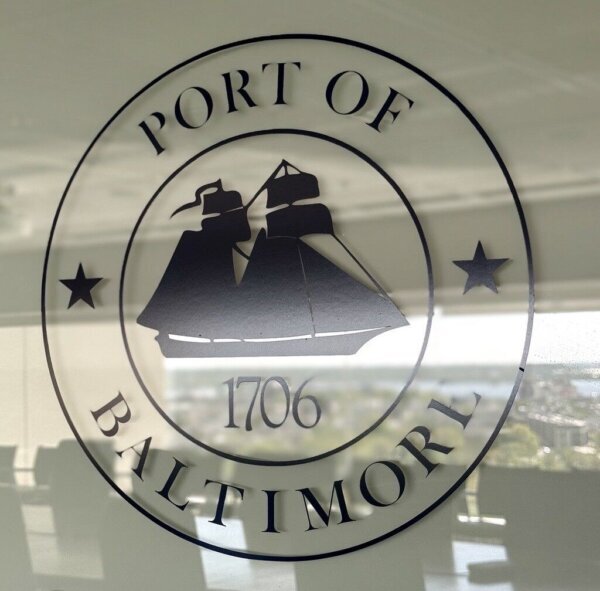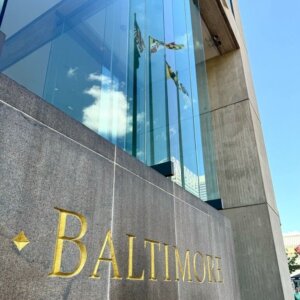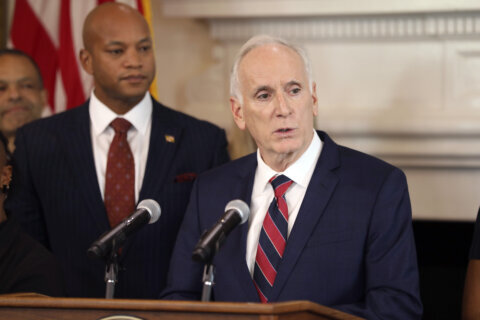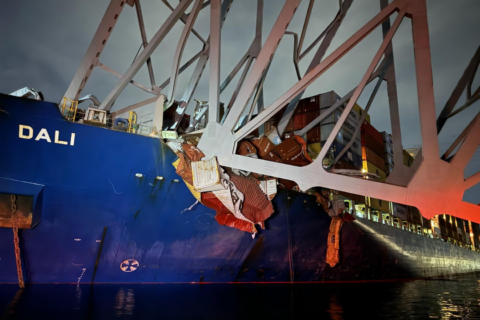Only seven weeks later, on March 26, Daniels found himself dealing with the tragic Francis Scott Key Bridge collapse, which claimed the lives of six construction workers and was “so catastrophic” that he said no one, including himself, could truly have been prepared.
Daniels sat down with WTOP to discuss what happened that day, what the response has been, and what kind of timeline and actions the Baltimore area — and entire nation — can expect to see in terms of rebounding from the devastating collapse.
‘Something that you really couldn’t believe’
The Key Bridge fell into the Patapsco River when the cargo ship Dali struck it after 1 a.m. on March 26 — unbeknown to Daniels for most of the night.
“It was interesting,” Daniels said. “I actually slept through a lot of the calls during that period of time.”
When he finally saw the multitude of texts and calls, Daniels called in and started to receive updates. Just seven weeks into his role as port administrator, Daniels said he didn’t expect anything like the collapse to happen.
“You try and train. You try and plan for a catastrophic event. I don’t think anybody really could have anticipated this type of catastrophic event,” Daniels said. “It wasn’t until I got to the command center that morning, when the sun was up, and starting to see the devastation. You see the vessel there, you see the bridge, and as you’re driving up, the lights to the bridge are gone. And so it was difficult until you really had the opportunity to set your eyes on it, to realize that what you were hearing on the phone, what you were being briefed about, actually had happened.”
More on the Baltimore Key Bridge collapse
- The latest on the Key Bridge collapse and recovery in Baltimore
- WTOP takes an up-close look at Baltimore Key Bridge collapse wreckage with US Coast Guard
- Interview with Army Corps of Engineers official on front line of Baltimore Key Bridge recovery
While Daniels knows there’s a long road ahead before the port can make a full recovery and the bridge can be rebuilt, he was quick to point out that doing right by those who died in the collapse and their families comes first.
“The governor has done an absolutely fantastic job during all of his briefings to make sure that is the first thing that he speaks about,” Daniels said. “We have Marylanders that have still not been recovered. We have families that don’t have closure, as of yet. So, that is still something that we deal with each and every day.”

The impact, at 1 month and counting
“We oftentimes talk about the fact that all of us are trying to make sure that we contribute to a large supply chain, and down in the southeast, you have a significant amount of manufacturers,” Daniels said. “In that regard, the way in which the supply chain is layered, we should see minimal amount of disruptions for at least a short period of time.”
However, Daniels said that “the longer this goes on, and the longer that the port is pulled out of that supply chain, the more impact you’re going to see with consumers.”
Daniels referenced Port Everglades in Florida and how it’s not necessarily clear how important one port is to an industry until it’s taken out of the equation.
“We’re all finding out how important the cruise sector is to the economy. We’re starting to find out how important the Port of Baltimore is to the economy of this region,” Daniels said. “And it’s not just Baltimore. This is not just a Baltimore, Maryland, issue. This is an issue that spans into Virginia, into the Washington, D.C., area and into Delaware. The Northeast itself and the Midwest relies on the Port of Baltimore.”
‘We want our cargo back’
Daniels said the response to the Key Bridge collapse has come on a “global basis,” starting on the morning of March 26.
“So many people, so many of my friends and colleagues from throughout the industry … all of them have asked, ‘What can we do to help?'” Daniels said. “And our answer is … when the salvage occurs and the structure is cleared and the channel is open, that you come back.”
Daniels said, in order to help with the recovery and rebound, he doesn’t want other ports that were temporary homes for cargo to become a “viable long-term option.”
“I’ve been very, very clear about the fact that when this is all over and the channel is clear, we want our cargo back,” he said.
Daniels said one of the most appealing aspects of his position is witnessing the pure passion for the maritime industry.
“It goes back to 1706, so, we’re more than 300 years old,” Daniels said. “When you consider that and you look at that type of passion, and that type of commitment to the industry … there is a fierce passion to be able to get this channel clear and to be able to get back to work.”
Looking toward the future
What does Daniels believe is key to getting the Port of Baltimore back to some type of normalcy?

“I think it’s continuing to work with the U.S. Coast Guard and the Army Corps of Engineers,” he said. “There’s lag time. There’s work that needs to be done to make sure that when the channel does open up, first, it’s not overwhelming, cause a backup and congestion. Everything needs to be done in an orderly and safe manner.”
While there is an obvious push to get people back to work, the area is still a recovery zone — but at the same time, “everybody’s looking at what is that date,” Daniels said.
“That’s frustrating for us because we want to give them some certainty at a time that is extremely uncertain,” he said.
Daniels said that despite the uncertainty, he has “not spoken to anybody who has given up on Baltimore.”
“We’re doing a lot to rebound as a community, region. And you saw that in some other areas of the United States — what happened down on the Gulf Coast with the recovery after Katrina,” he said. “The fact of the matter is, things occur. There are catastrophic events. We try and prepare for it as much as possible. It’s how we recover and how we rebound that really shows the mettle of this region. I am just so sure that we’re going to rebound and come back even better from this.”
Get breaking news and daily headlines delivered to your email inbox by signing up here.
© 2024 WTOP. All Rights Reserved. This website is not intended for users located within the European Economic Area.









